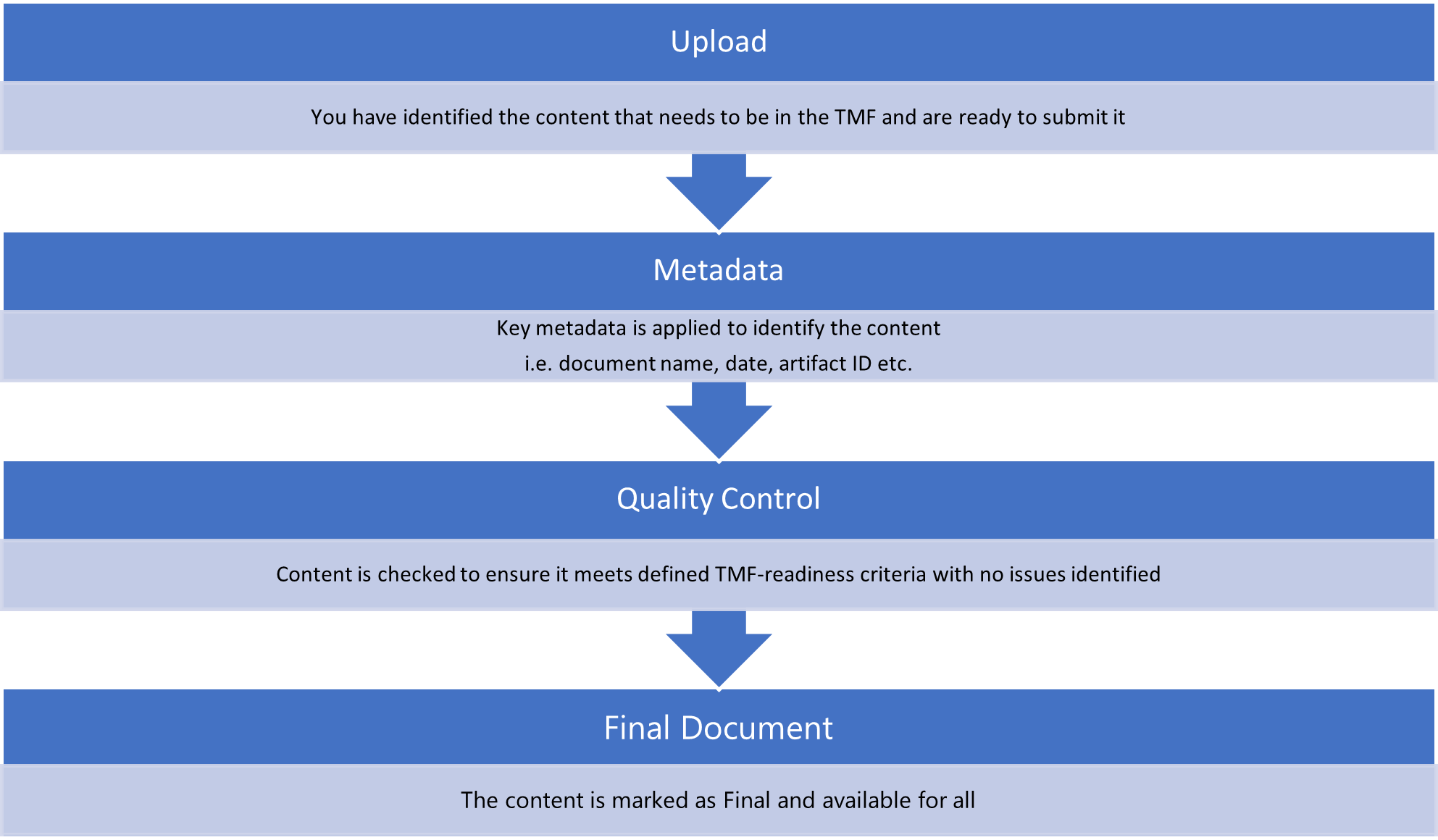And we are back with another season of blogs guys, I know you missed my ramblings after the Clinical Trials and TMF 101 last year so how about a whole new batch of content looking at how the eTMF has changed the world of TMF Management.
In this first blog I want to talk about processes, and how there is basically one core process that every single eTMF system has.

The secret no one will ever say out loud is that every single eTMF system worth its weight will do this, this isn’t anything special, its nothing propriety or locked behind a vault like the Coke recipe. So, if the process is simple, and every eTMF system out there does it… why do we all struggle, why do we end up in situations where we have massive training plans and people confused. Well, I’ll tell you why, it would be a boring blog if all I did was raise questions, it’s because we all want “Options” let’s go through each step one by one.
Submitting content to the TMF:
A lot of system allow you to do a simple upload, you have a file on your computer then you simply upload it to the correct location in the structure you are using. It is quick, it is simple, and it retains the accountability to the person submitting the content. But we don’t always stop there, we want to add options, options for those who don’t understand the TMF, options for those who want to upload now but manage later, options for those that don’t even want to log into the eTMF; they just want to fire off emails with attachments like a shoot-out in a western bar. Now I am not saying that these different models do not have their uses but ask yourself, Do you need to have all these options?
Simple, a word I use a lot, let’s keep it simple. Are you using a model where each group owns their own content, then just giving people access so they can upload their own stuff makes sense here. Maybe you have enough staff you are using a central filing system where documents are sent to a single point and then managed, well an email solution or holding area to upload and manage later works perfectly well. The key thing is to understand what processes the system can actually support, then use the ones that make sense. I would say that understanding your working model and what process your vendor has built in as standard is one of the main things you should be discussing when looking for a system. Trying to fit a process to a system that was not built that way can end in disaster.
Adding the data to the data so you can go back later and find the data:
If there is somewhere people will try and be clever it’s here. Metadata for those who don’t remember is the data about the content you are uploading, it’s the Zone, Section and Artefact the content is associated to, it’s the date recorded on the document or the version number of that upload. There are certain pieces of metadata that are essential and required to find things in the future, there is also the metadata that will help you check on the health of your TMF, but ask yourself, if the metadata I am collecting does not do either of these… why do I care? Sure, you could record what the weather was like on the day you uploaded that Sub-I CV but is that useful. One of the common complaints from users is having to add metadata, if done right they should be adding a handful items max. If it’s not useful, get rid of it.
You can’t mark your own homework:
You have worked out what you need to upload, you got it in the system and added everything you needed. Sometimes thats enough; submit, index, final. But, do we trust you? It doesn’t hurt to get a second pair of eyes to look at it, “Trust but verify” is a term I hear a lot.
What should we look at? Well we will check if you firstly uploaded something that was worth uploading. Are all the pages there, are there too many pages, is there a lot of information that shouldn’t be there, like that patient’s name, date of birth etc. Checking that can help remove problems before they become a real pain. Let’s also make sure it was filed to the correct spot, last thing you want is to be sat there saying to the MHRA in two years’ time “I’m sure it’s in here, I remember uploading it” before finding that Regulatory Approval stored under the Informed Consent Form. What we want to make sure of is that there is a simple list of checks everyone is doing and. Consistency is your friend here, try not to make too many changes, I see too many companies changing the rules monthly, how is anyone ever supposed to learn.
Side Note: It’s worth mentioning here that we talk a lot about “Risk Based QC”, the idea is that not every document is created equal. Do you need to QC every set of meeting minutes or should you turn your attention to more complex and important documents. This is a great idea and when done properly it can really help when you have hundreds and thousands of documents being uploaded, however if you only have a couple of studies and therefore a few dozen docs uploaded on a weekly basis don’t feel like you need to add this complexity because it sounds cool. TMF Management is a marathon, not a sprint.
Done and dusted:
The final step in this process is the document going to final, it has been identified, uploaded, metadata added and someone else has given it the stamp of approval. It’s now available for all to see in the system. For a lot of stuff in the TMF that’s it, you won’t have to check it again unless you are doing periodic reviews later down the line. It really should be as simple as a one or two clicks maximum, all the hard work is done so why make it harder than it must be.
You will have noticed there is a real trend here, “Options”, avoid them. We think we like options, but we don’t. We are simple creatures, and we like to have a simple answer. The TMF is just one of many jobs someone will have in a day so in most cases they just want to get their job done right first time. For those of you that already have an eTMF in place, think of your process and does it fit on a single slide? If not, should it? A well-defined process should be simple, this will help you and your colleagues understand it and make life a lot easier when training people. For those of you looking at a system, understand the model you will be using, in-house vs CRO, Distributed vs Centralised and ask the vendor to describe how their system will support that. Simple processes are key to achieving quality, the less points of failure the better.
The next blog will take a look at metrics and how the eTMF can open your eyes to a whole new world of TMF management, however once again, our arch nemesis “Options” will play a part. Until then.
Take Care
Rob Jones
If you missed the Clinical Trials Series Launch you can now watch it on demand here. And don't forget to sign up for series close Ask An Expert session - you can register here.
.png?width=300&name=PharmaLex_RGB%20(1).png)

